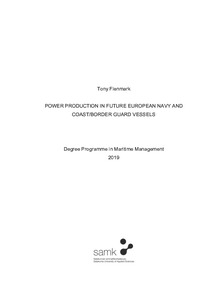Power production in future European navy and coast/border guard vessels
Flenmark, Tony (2019)
Flenmark, Tony
2019
All rights reserved. This publication is copyrighted. You may download, display and print it for Your own personal use. Commercial use is prohibited.
Julkaisun pysyvä osoite on
https://urn.fi/URN:NBN:fi:amk-201905067742
https://urn.fi/URN:NBN:fi:amk-201905067742
Tiivistelmä
POWER PRODUCTION IN FUTURE EUROPEAN NAVY AND COAST/BORDER GUARD VESSELS
Flenmark, Tony
Satakunta University of Applied Sciences
Degree Programme in Maritime Management
May 2019
Pages: 73
Appendices: 1
Keywords: naval fleet, machineries, coast guard, technical development
____________________________________________________________________
Fast combat vessels have been built almost in the same way since the early 1900s. There are several old-established machineries lay-out used in combat vessels, the most common of them being, due to the speed demand, diesel engine – gas turbine combination. Naval administrations are clearly eager to build more energy-efficient and environmentally friendly combatant and non-combatant vessels. In this development, machinery manufacturers want to be involved in earliest possible stage.
The purpose of this thesis was to compare current machineries used in naval combatant and non-combatant vessels and to explore the possibility to use new technologies in future newbuilding vessels. The use of rules and regulations for the construction of warships was also worth exploring, especially since their use was found to be very different in comparison to the construction of merchant ships. The age distribution of the different vessel classes was also studied with a view to perceiving potential future building projects that the subscriber of this thesis would be able to participate in.
Even if the machinery solutions are constantly being developed to more energy efficient and environmentally friendly, only some of these solutions will probably be used in the future. The intention was also to perceive the most likely future machinery solutions to combatant and non-combatant vessels.
Warfare vessels covered in this thesis were divided into two main groups, combatant and non-combatant vessels and into two subdivisions, vessels operating in ice covered areas and open water vessels. Division into main groups was found necessary because machinery, hull and speed requirements differ significantly depending on the purpose of these vessels. Likewise, the possibility of using new technologies on these ships is very dissimilar.
Flenmark, Tony
Satakunta University of Applied Sciences
Degree Programme in Maritime Management
May 2019
Pages: 73
Appendices: 1
Keywords: naval fleet, machineries, coast guard, technical development
____________________________________________________________________
Fast combat vessels have been built almost in the same way since the early 1900s. There are several old-established machineries lay-out used in combat vessels, the most common of them being, due to the speed demand, diesel engine – gas turbine combination. Naval administrations are clearly eager to build more energy-efficient and environmentally friendly combatant and non-combatant vessels. In this development, machinery manufacturers want to be involved in earliest possible stage.
The purpose of this thesis was to compare current machineries used in naval combatant and non-combatant vessels and to explore the possibility to use new technologies in future newbuilding vessels. The use of rules and regulations for the construction of warships was also worth exploring, especially since their use was found to be very different in comparison to the construction of merchant ships. The age distribution of the different vessel classes was also studied with a view to perceiving potential future building projects that the subscriber of this thesis would be able to participate in.
Even if the machinery solutions are constantly being developed to more energy efficient and environmentally friendly, only some of these solutions will probably be used in the future. The intention was also to perceive the most likely future machinery solutions to combatant and non-combatant vessels.
Warfare vessels covered in this thesis were divided into two main groups, combatant and non-combatant vessels and into two subdivisions, vessels operating in ice covered areas and open water vessels. Division into main groups was found necessary because machinery, hull and speed requirements differ significantly depending on the purpose of these vessels. Likewise, the possibility of using new technologies on these ships is very dissimilar.
